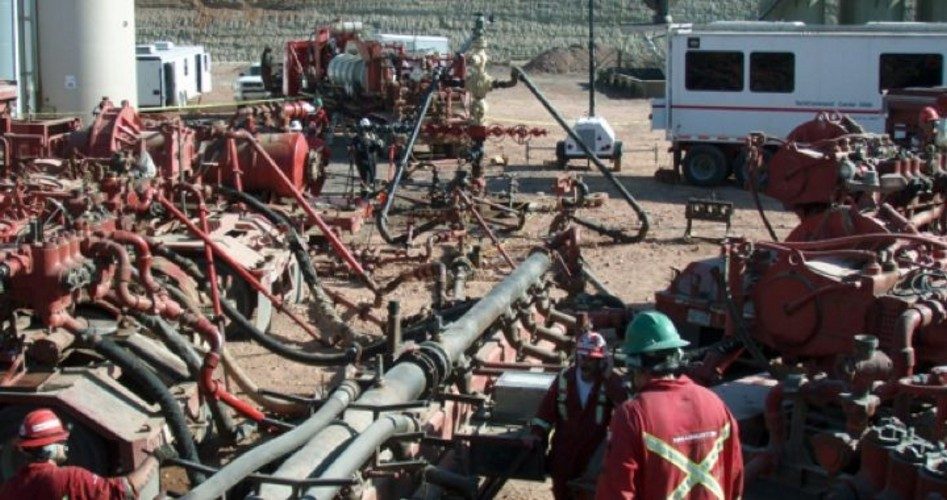
Now that “everyone is on board” with a nine-month extension of last November’s agreement to cut production by OPEC, tomorrow’s meeting of the cartel in Vienna is expected to rubber-stamp that extension. Saudi Arabia’s oil minister, Khalid al-Falih, upon returning from Iraq on Monday, said, “We think we have everybody on board. Everybody I’ve talked to indicated that nine months [is] a wise decision.”
Iraq was the most egregious cheater under the November agreement, first complaining that the production numbers upon which its “participation” was based were too high, and then being very slow in implementing those cuts. The slack was picked up by Saudi Arabia, which cut more than it agreed to.
The overall goal of the cuts is to reduce the world’s inventory of crude oil from 3 billion barrels to its five-year average of 2.7 billion, a reduction of 300 million barrels. That would force the world price of crude higher, helping to reduce the deficits the cartel’s members have been running since 2014 when oil first dropped below $100 a barrel. The average OPEC member needs oil at $95 a barrel to fund its welfare and military costs.
The original agreement crafted in November called for cuts (including non-OPEC members such as Russia) of 1.8 million barrels per day. The latest numbers show that, at best, OPEC has cut its production by a little over a million.
This was occurring while U.S. shale oil producers were increasing their production of crude by nearly 800,000 barrels a day. Combined with increases from Canada and Brazil, the net effect of the November agreement was essentially zero.
The “invisible presence” in Vienna is the U.S. fracking industry — the elephant in the living room that everyone is aware of but no one is willing to talk about. Alan Eyre, the State Department official who keeps tabs on Middle East energy, was spot on: “The more success OPEC has in complying with and extending its November deal, the more it ensures [that] U.S. production bounces back.”
Thanks not only to technological improvements but exotic hedging techniques in the futures market, the American oil industry is producing 9.3 million barrels of crude every day, with best estimates that it will hit 10 million barrels per day early in 2018.
Technology has allowed Laredo Petroleum, for example, to “super-size” its horizontal wells to two miles long in each direction, allowing wells to produce twice what they were able to just a year ago. In addition, Laredo is now able to install a new rig twice as fast as before, pushing its breakeven costs to under $40 a barrel. That’s down from $63 just three years ago.
In addition, Laredo and others have become skilled at using a variety of financial instruments — hedges, collars, and swaps — to insulate against falling oil prices. This has not only ensured their continued operations but have made it easier for venture capital funds to offer their financial assistance, taking comfort that there is a floor below which prices received by the producers cannot fall.
Laredo has hedged some 70 percent of its future oil production for 2017 so that when oil prices dropped below $50 a barrel earlier this year, it was able to receive $56 a barrel, well above its breakeven point.
Big players such as Exxon Mobil are shifting to short-cycle, high-return shale investments in both the Permian Basin and the Bakken Formation where the company’s combined 5,500 wells are profitable at less than $40 a barrel.
Iraq, despite assurance from Saudi Arabia’s oil minister, could wander off the reservation under the new agreement just as it did under the old one. British Petroleum, Royal Dutch Shell, Exxon Mobil, and others with facilities in oil fields around Basra are completing maintenance and bringing new wells online. In March Iraq’s oil minister Jabbar Al-Luaibi bragged, “We achieved this great achievement of 4 million barrels per day [in the] middle of 2016, and now we have climbed up and we are reaching about 5 million barrels per day [by] the beginning of the second of half of this year.”
How willing is Iraq going to be to let those new and refreshed production facilities remain idle in order to keep up its end of the bargain to be signed in Vienna on Thursday?
Here is what the U.S. fracking industry’s “invisible presence” in Vienna means, according to Sushant Gupta, research director for energy consultancy Wood MacKenzie:
Production cuts cause higher prices which will incentivize more production from the U.S. shale oil [industry] and reduce the impact of the production cuts [scheduled to be extended by OPEC in Vienna on Thursday].
U.S. frackers must be positively salivating over the prospects of the extension continuing to take OPEC production off the market which they are only too happy to replace.
Photo of fracking operation: Joshua Doubek
An Ivy League graduate and former investment advisor, Bob is a regular contributor to The New American magazine and blogs frequently at LightFromTheRight.com, primarily on economics and politics. He can be reached at badelmann@thenewamerican.com.



